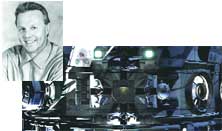
Rhythm & Hues created the gaseous atmospheric environment for Solaris, with Cinesite handling the compositing via Cineon.
|
HOLLYWOOD - In sci-fi fandom, Steven Soderbergh's upcoming re-rendering of the 1972 classic Solaris is the event film of the year, but don't expect flashy visual effects to be at the heart of the story. Cinesite visual effects supervisor Tom Smith says, "Even though the film takes place entirely in deep space, with flashbacks to Earth, the story focuses on the characters and their relationships. Steven [Soderbergh] is a master at using digital technology to enhance a sense of reality, including knowing when an effects shot is appropriate and when to let something play off camera."
Cinesite has worked with Soderbergh on five previous films: Out Of Sight, The Limey, Erin Brockovich, Traffic and Ocean's Eleven.
"Steven is very comfortable with digital technology," says Smith. "He's clear about what he wants, including applying the technology in post to fine tune images. Solaris is a great example of how digital technology can be used to create cool shots and also make better movies."
The work
Cinesite contributed both 2D and 3D effects, including spaceships and pods, CG waterscapes, and the creation of CG wounds and damaged tissue. The planet Solaris and several other effects elements were generated by Rhythm & Hues and composited at Cinesite. Some composites included as many as 50 layers of interactive light and gaseous emanations from the planet.

Cinesite used Maya to create the film's docking and space stations. VFX supervisor Tom Smith is inset.
|
Most of Cinesite's work involved three CG spaceships. The main character travels to the Prometheus in a smaller ship called the Athena. It includes a pod that detaches and carries the character to Prometheus. The docking sequence is about two and a half minutes long and is made up of eight or nine long, majestic shots that were all computer generated.
"They provided us with some original designs, and John Hewitt and Mark Shoaf worked from those to develop the detailed CG ships," says Smith. "The Prometheus is a rather large spaceship, and the level of detail once we get in close is amazing."
Smith says that lighting the CG spaceships was critical for believability. More than 2,500 textures were used to create the ship. Smith and the Cinesite team used the new IMAX film Space Station as a visual reference.
"There's a real distinctive quality to the light in space," says Smith. "There's no atmosphere, so it's crystal clean and sharp. We also took note of the level of dirt on surface materials, how they react to light, and how the shadows look or the fill light that reflects the planet. We're adding a kind of glow to the light, bits of intense white with texture details. Seeing Space Station was very helpful, because it's very recent footage, and it was shot on film in the large IMAX format."
Smith says that Soderbergh has a good eye for photorealism. "He knows what an anamorphic defocused background should look like and it's our job to match that look. He appreciates the consistency we offer. Quality-wise, whatever he brings in, he gets back - the colors, the contrast and density, are right. He has no worries about getting things to match once they're cut together."
The Wound
In another effects-laden sequence, the main character's deceased wife, who has re-appeared on the spaceship, tries to commit suicide by drinking liquid oxygen. Her face and neck are dramatically burned and then we see her wounds heal and she comes back to life.
The wounds were created in 3D and motion tracked to the actress's facial movements. Cyber scans of her face and body were done with 3D cameras by Gentle Giant, a company in Burbank that specializes in the process, which results in a 3D model. Cinesite used the topography in Alias|Wavefront Maya, adding photographed skin textures and painting in the wounds. The wounds also required geometry modeling, which gave Smith and his team control over how they moved and how deep they were. Smith explains that adjusting the degree of transparency helps to make a convincing blend of the painted areas and the "real" skin. Graduated mattes helped feather the edges.
"We did a lot of procedural techniques in [Side Effects] Houdini and [Pixar] RenderMan to create different levels and to add different colors to those levels," says Smith. "There is a lot of fine, minute detail that is going on inside the wound that heal in layers for the final shot."
Once the images were manipulated, the frames were output to an internegative using the Lightning Film Recorder. The effects shot was printed on Kodak Vision Premier print film, which renders a slightly contrastier image.